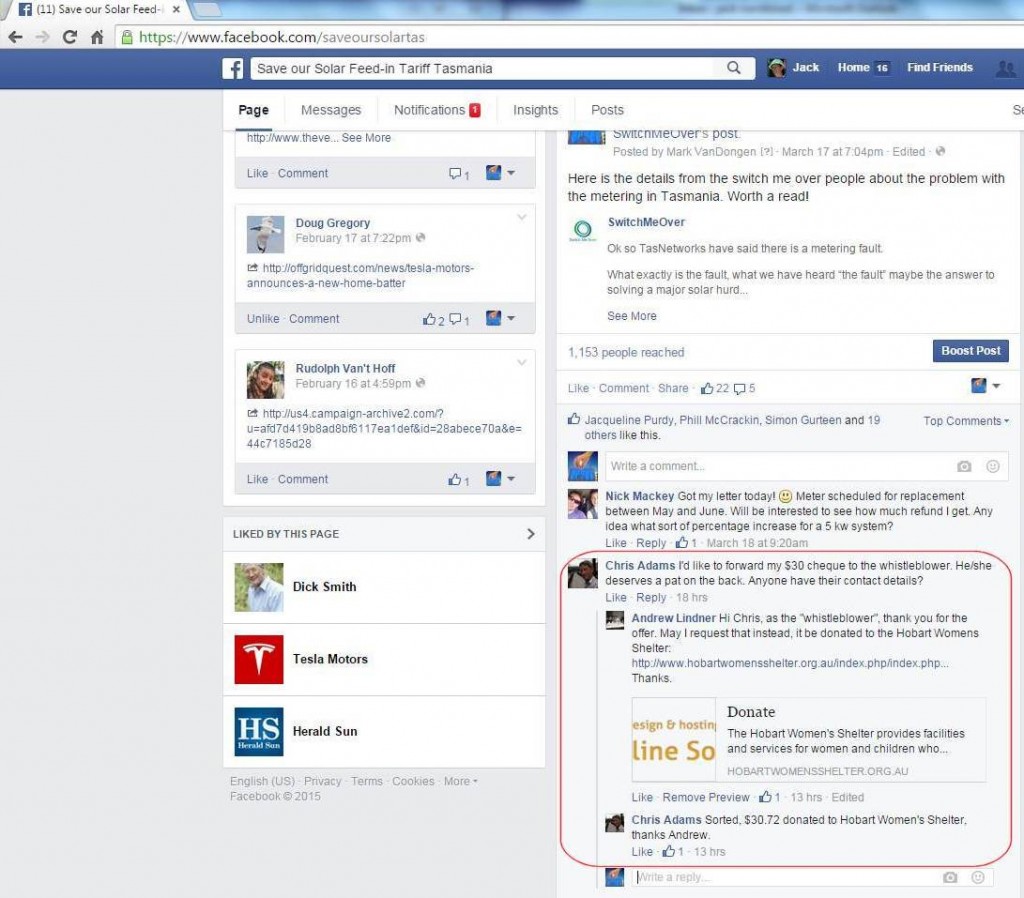Solar metering
Solar owners in Tasmania who signed up after 31 August 2013 are not getting the full value of the solar energy they generate if they are on both light & power and a heating tariff. In fact at times these solar owners are feeding electricity into the grid but are paying an energy charge as if they were receiving electricity from the grid. Another way of looking at the problem is that, in some circumstances, solar owners are paying Aurora 9c/kWh for electricity they generated themselves.
Background – offsetting two tariffs
In August 2013, when the solar feed-in tariff was being reduced from 28c to 8c, we identified that solar owners would not get the full value of their solar generation because the meters only offset power generated against consumption on the light and power tariff. In response to this, the state government instructed Aurora to implement “as soon as practical” a “technical metering solution that provides small customers who connect a distributed generation system from 31 August with the option of off-setting their on-site electricity consumption for hot water and heating – in addition to light and power – before electricity is exported to the grid.”
TREA followed up on this with the previous and current government as well as with Aurora Networks. Initially we were told a solution was not technically feasible. Subsequently we have followed up with TasNetworks who advised that a solution was possible but that it would require special software to be written by EDMI, the meter supplier for Tasmania.
In September 2015 TasNetworks received software from EDMI for testing.
On 30 October 2015 Matthew Groom wrote to Greens energy spokesperson Rosalie Woodruff and said “Should this testing prove successful, TasNetworks would then proceed with a broader roll out.”
On 1 March 2016 TasNetworks CEO Lance Balcombe wrote to TREA saying that “a workable solution was identified” but would not be implemented because of the cost and because this solution was not compatible with TasNetworks’ long term tariff strategy to move all residential and business customers to time of use network tariffs (in other words the existing bundled light & power and cheaper heating & hot water tariffs would not be available).
The TasNetworks letter suggests that “customers already have options that allow them to fully offset micro-embedded generation”.
Currently the only option available to residential customers is to put all their consumption onto tariff 31 (ie pay 25c instead of 15c for their hot water and heating).
The letter refers to a “Residential Low Voltage Time of Use tariff (TAS93)” but this is a network tariff and Aurora does not offer a retail tariff on this basis. We understand that Aurora intends to offer a residential time of use tariff from July 2016 (and possibly a ‘demand time of use’ tariff) but we will not know until Aurora tariff proposals are released for comment by the Economic Regulators shortly.
Any change of tariff requested by a customer normally involve meter changes which cost from $179 to $250.
None of the ‘solutions’ are fair to solar owners, who have been missing out on getting the full value from their PV purchase, in some cases for over two years.
What we want – offsetting two tariffs
We are calling on Matthew Groom, the state energy Minister to:
- instruct TasNetworks to implement the metering software that offsets both tariffs for all new solar connections and existing solar customers who ordered after 31 August 2013.
- instruct TasNetworks that solar owners should not have to pay for a replacement meter to implement the correct software.
TasNetworks solar meter replacement program
TasNetworks announced on 16 March 2015 that 8,200 customers may not have not been correctly paid for the solar power they have exported to the grid. In some cases the problem goes back to 2011. TasNetworks has implemented a program to replace the affected meters at no cost to customers. At the end of May 2015, 1,951 meters had been replaced and the program is on target to replace all 8,200 meters before the end of 2015. To the end of May the average refund per installation was $202 with a range of $0 to in excess $800. The refunds vary widely because they depend not only on the size of the solar installation, but also on whether the customer is on the legacy or current FiT rate, and on the extent to which the customer was consuming power on a heating circuit at the same time as they were generating solar energy. Refunds are not estimates and are based on actual generation and consumption data retrieved from the replaced meters.
More information
- Our TREA Fact Sheet – metering of solar customers in Tasmania (ver 1.04, 25 Mar 2015) provides more detail on how solar meters work and the changes required to fix both this problem.
- Letter from Matthew Groom 30 Oct 2015 saying that the software would be rolled out once it was tested.
- Letter from TasNetworks CEO Lance Balcombe 1 Mar 2016 saying that the metering solution will not be implemented.
Media coverage
- Solar panel users pay for meter woes, Blair Richards, The Mercury, 7 Mar 2016
- Are solar homes getting paid properly for their solar exports?, Sophie Vorrath, RenewEconomy 17 Mar 2015
- TasNetworks to pay up on credits after customers short-changed on solar, Blair Richards Mercury 16 Mar 2015
$30 payments from TasNetworks
TasNetworks have posted a $30 cheque to those who will require a meter change. This is in addition to any future payment for under-metered solar energy fed into the grid.
If you received a cheque and are wondering what to do with it, Andrew Lindner, who identified the metering problem and convinced TasNetworks that it was real, suggests you might like to donate it to a local charity such as the Hobart Women’s Shelter.

